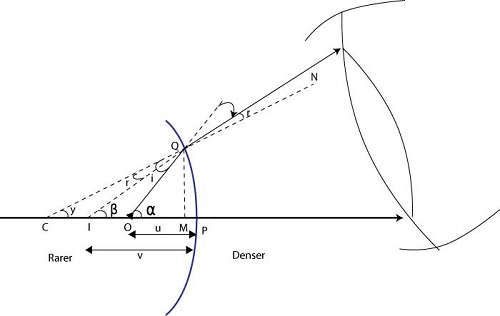Refraction Through Concave Surface
Description:
Consider a spherical surface which separates medium-1 and medium-2.

Consider a point object ‘O’ on the principle axis in medium-1 which is rarer.
One Incident ray goes un-deviated through medium-2 along principle axis.
Consider a second ray OQ, incident on surface, which makes an angle of incidence ‘i’ at point Q. After refraction, it bends towards the normal as it is moving from rarer to denser medium.
These two rays do not intersect actually so real image of the object is not formed, but if both the ways are drawn backwards they intersect at point ‘I’ which is a virtual image.
We have from Snell’s law −
μ = sin isin r
From our assumptions made earlier we get −
sin i = i and sin r = r
Therefore,
i = μ r
From figure we can obtain −
i = α - γ and r = β - γ
∴ α - γ = μ(β - γ)
∴ α - γ = μβ - μγ
∴ α - μβ = γ(1 - μ)
Again using assumptions, we get −
∴ tan α - μ tan β = tan γ(1 - μ)
Suppose in figure point M is very close to P.
From figure −
tan α = QMOM and tan β = QMIM and tan γ = QMCM
Substituting values, we get −
QMOM - μQMIM = QMCM(1 - μ)
Divide the equation by QM
1OM - μ1IM = 1CM(1 - μ)
Substituting values of OM, IM, CM in optical terms from figure –
1-u - μ1-v = 1-R(1 - μ)
∴ μv - 1u = (μ - 1)1R
Where,
μ = Refractive index.
v = Image distance.
u = Object distance.
R = Radius of Curvature.
This equation is for the case when object is placed in rarer medium and image is also formed in the rarer medium and it is a virtual image and curved surface is concave.

